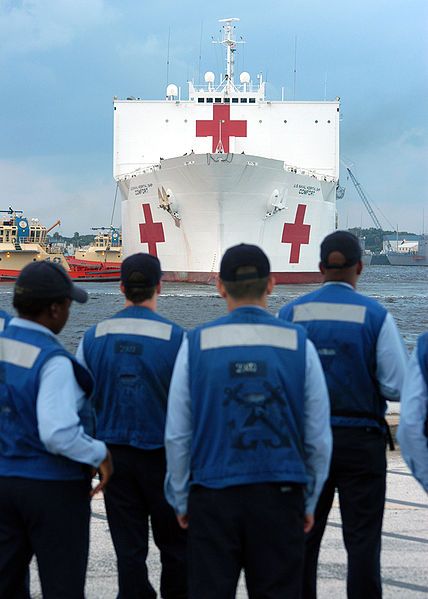 The Navy's new strategy for sacving the world. In the U.S. Navy, flaoting hospital ships are curing the sick and healing the blind. It's all part of hte Pentagon's plan for global domination.
The Navy's new strategy for sacving the world. In the U.S. Navy, flaoting hospital ships are curing the sick and healing the blind. It's all part of hte Pentagon's plan for global domination.
For millions of people in Latin America, Africa, and Asia, the U.S. Navy no longer conjures up images of war games and nuclear submarines. Instead, the sight of American sailors means one thing: free medical care.
In recent years, the Navy has started dispatching dozens of hospital ships—some as big as shopping malls—to aid developing nations. The crews consist of doctors, nurses, engineers, pilots, volunteers, and even acupuncturists, all there to help. But as mental_floss reporter David Axe learned while visiting the Kearsarge ship in Nicaragua, the Nashville in Gabon, and the Comfort in Panama, these missions aren't about altruism; they're about winning friends and influencing nations.
Soft Power
The U.S. Navy has been in the medical business for decades, often setting sail in response to earthquakes or hurricanes. But until recently, these missions were for emergencies only, and not part of a bigger diplomatic strategy. It took the Iraq War to change that.
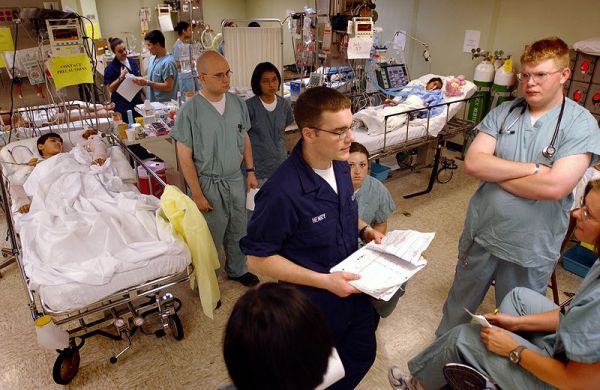 After years of failing to pacify Iraq with firepower, the Pentagon decided it needed to think outside the arsenal. The result was a new theory called "soft power." The idea is to send the military into potential conflict zones—along with other government agencies and civilian volunteers—years before any fighting breaks out. The troops hand out free medical care, aid local governments, and build roads and schools. Basically, they do anything they can to be of assistance.
After years of failing to pacify Iraq with firepower, the Pentagon decided it needed to think outside the arsenal. The result was a new theory called "soft power." The idea is to send the military into potential conflict zones—along with other government agencies and civilian volunteers—years before any fighting breaks out. The troops hand out free medical care, aid local governments, and build roads and schools. Basically, they do anything they can to be of assistance.
By giving everyone a helping hand, soft-power programs hope to improve the United States' image and leave a lasting, positive impression of America on the citizens of other nations. "It's about influencing generations to come," says Navy Commodore Frank Ponds.
Beginning in 2006, the Navy sent ships to places where conflicts were simmering. Then, in November 2007, Defense Secretary Robert Gates made soft power official policy during a speech at Kansas State University. Now, it's all the rage at the Pentagon. There is at least one major soft-power mission to Asia, Africa, and Latin America each year, meaning U.S. Navy ships are already becoming an increasingly common sight all across the world.
The Nuts and Bolts
The Navy's two largest hospital ships, the Comfort and the Mercy, are 900-ft.-long modified oil tankers with triage bays, surgical wards, and 1,000 patient beds. To give you an idea of how big that is, each ship is nearly on par with Los Angeles' Cedars-Sinai Medical Center in scale. In fact, during its "Operation Continuing Promise" mission to Latin America in 2008 the Comfort treated more than 100,000 patients.
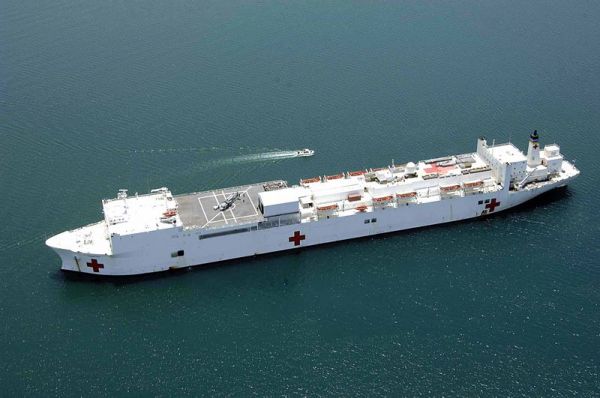
According to Captain James Ware, the medical operations commander on the Comfort, his staff of nearly 200 doctors and nurses can perform almost any procedure, from plastic surgery to physical therapy. The only things they can't do are open-heart surgery, total joint replacement, and organ transplants, because they lack certain specialized pieces of equipment.
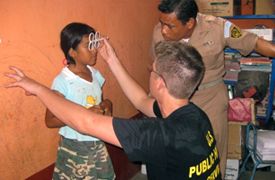 Naturally, the setup for all of this is fairly complex. Teams of doctors and nurses go ashore and establish "instant" health clinics. There, people can get treatment for simple medical and dental problems; they can pick up free meds from a portable pharmacy or free eyeglasses from a military optometrist; they can even get basic veterinary treatment for their pets and livestock. But when the procedures are more complicated, the Navy transports patients onto the ships. In Latin America in 2008, Operation Smile, a nonprofit organization specializing in facial plastic surgery, set up shop aboard the Kearsarge and shuttled in patients. During the ship's four-month tour, its doctors treated 15,000 people and repaired 200 severe cleft palates.
Naturally, the setup for all of this is fairly complex. Teams of doctors and nurses go ashore and establish "instant" health clinics. There, people can get treatment for simple medical and dental problems; they can pick up free meds from a portable pharmacy or free eyeglasses from a military optometrist; they can even get basic veterinary treatment for their pets and livestock. But when the procedures are more complicated, the Navy transports patients onto the ships. In Latin America in 2008, Operation Smile, a nonprofit organization specializing in facial plastic surgery, set up shop aboard the Kearsarge and shuttled in patients. During the ship's four-month tour, its doctors treated 15,000 people and repaired 200 severe cleft palates.
For more difficult surgeries, the Navy has developed a high-tech system called telesurgery to help its doctors consult specialists back in the United States. The combination of networked digital video cameras, speakers, and flat-screen televisions allows surgeons at sea to communicate with specialists in America. When the program made its debut during the Comfort's 2008 stop in Antigua, Army Colonel Ernest Lockrow, the doctor in charge of developing the system, reported that they experienced only a half-second delay.
Managing the Press

In some areas, the patients treated at these hospital ships have never seen a doctor before, so the Navy's arrival can be an almost miraculous event. But if soft power sounds like all good news with no downside, there's a reason. The Navy carefully manages the press coverage of its hospital ships in order to emphasize the positive. It's all part of the strategy. For every person his doctors treated in 2008, Commodore Ponds says he wants 10 other people to hear about it. It's no surprise that most Navy hospital ships sail with large numbers of reporters on board. In August 2008, Navy doctors performed eyelid surgery on an 11-year-old boy to remove a mysterious growth that had impaired his vision and made him an outcast in his Nicaraguan village. Of course, there was a journalist standing by to get a quote from him the moment he could see again. The boy reportedly said, "I can now read my textbooks... I am very happy."
 In reality, soft power isn't perfect. A visit by one of the Navy's hospital ships is like instantly building a brand-new, full-service hospital in one of the world's poorest communities, running it at full capacity for two weeks, and then shutting it down in an afternoon. All the high technology can't replace the sustained, hands-on care a patient could get from a permanent, local clinic. Comfort surgeon Commander Timothy Donahue, for instance, admits that he had to avoid doing tricky procedures that could require highly specialized follow-up care.
In reality, soft power isn't perfect. A visit by one of the Navy's hospital ships is like instantly building a brand-new, full-service hospital in one of the world's poorest communities, running it at full capacity for two weeks, and then shutting it down in an afternoon. All the high technology can't replace the sustained, hands-on care a patient could get from a permanent, local clinic. Comfort surgeon Commander Timothy Donahue, for instance, admits that he had to avoid doing tricky procedures that could require highly specialized follow-up care.
Another problem is that most Navy personnel are trained to handle war, not peace. To work with civilians, many have had to completely rethink the way they do their jobs. Marine Corps Major Alison Thompson flew some of the most daring combat missions in Afghanistan before joining the Kearsarge as a hospital chopper pilot. When landing in a war zone, Thompson would shoot at anyone rushing towards the helicopter, for fear they might attack. But in Nicaragua, impoverished residents often run towards the chopper looking for food. Even if someone were caught stealing something from her helicopter, Thompson's orders are to let them go. This new way of thinking is the hardest part of her job, she says.
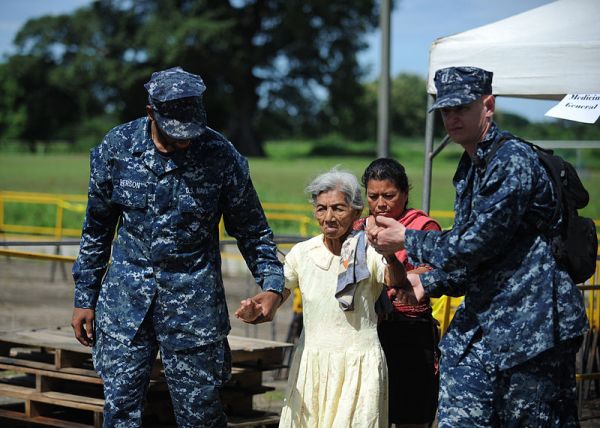 In Africa, the Navy has faced similar problems. When the Nashville tried to set up a clinic for abused children in Gabon, none of the sailors gave a second thought to the camouflaged uniforms they were wearing. But when the children saw their military garb, they thought the Americans had come to enslave them. For several minutes, there was complete pandemonium, as the children ran, screamed, and hid. "They've had difficult lives," explained Gabriela Escudero, a State Department humanitarian official. In the end, it took Escudero's gentle coaxing to convince them that the sailors were there to help.
In Africa, the Navy has faced similar problems. When the Nashville tried to set up a clinic for abused children in Gabon, none of the sailors gave a second thought to the camouflaged uniforms they were wearing. But when the children saw their military garb, they thought the Americans had come to enslave them. For several minutes, there was complete pandemonium, as the children ran, screamed, and hid. "They've had difficult lives," explained Gabriela Escudero, a State Department humanitarian official. In the end, it took Escudero's gentle coaxing to convince them that the sailors were there to help.
To bridge that gap between the military and the people they're trying to help, the Navy has begun recruiting civilians. No fewer than 300 volunteers from several major non-governmental organizations, such as Project Hope and the Church of Latter Day Saints, joined the Comfort in 2008. The ship's crew even included one California acupuncturist. "Diversity is going to make an organization that much better," said Captain Bob Lineberry, commanding hospital officer on the Comfort.
Copycats
Soft-power missions are sometimes messier than the Navy admits, but they still beat withholding aid until a crisis arises. And if imitation is the sincerest form of flattery, then soft power is a smashing success. The Dutch navy asked for American help launching its own hospital-ship mission last summer, and last June, the Chinese navy contacted the Pentagon requesting permission to send a 10-man medical team to visit the Comfort during the hospital ship's planned visit to Colombia. "They're putting together a hospital ship and are interested in how we do our business," Captain Ware explained. During the Cold War, superpowers fought for control of the Third World by selling arms and staging coups; today, they're competing to be the world's best helpers. In the end, soft power may prove to be exactly the type of strategy we need to make the world a better place.
 (YouTube link)
(YouTube link)
________________________________
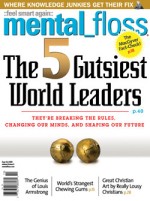 This article by David Axe is from the September-October 2008 issue of mental_floss magazine. It is reprinted here with permission.
This article by David Axe is from the September-October 2008 issue of mental_floss magazine. It is reprinted here with permission.
Don't forget to feed your brain by subscribing to the magazine and visiting mental_floss' extremely entertaining website and blog today for more! 
via Neatorama http://www.neatorama.com/2013/04/26/How-to-Win-Friends-and-Inoculate-People/
 A good way to assess how excited you'll be to work somewhere is by seeing how excited current employees are about their work. With that in mind, code blog Runtime Era suggests that you ask your interviewer what the most interesting thing they've worked on during their time with the company was.
A good way to assess how excited you'll be to work somewhere is by seeing how excited current employees are about their work. With that in mind, code blog Runtime Era suggests that you ask your interviewer what the most interesting thing they've worked on during their time with the company was.







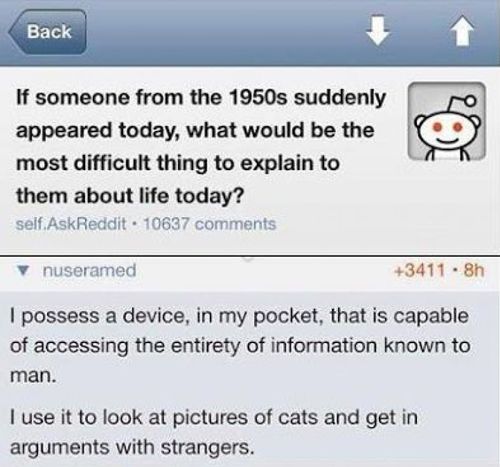

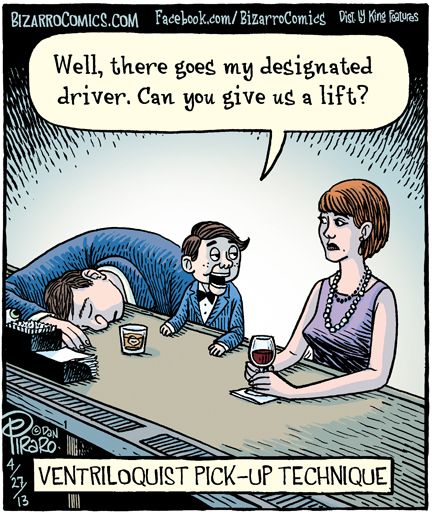
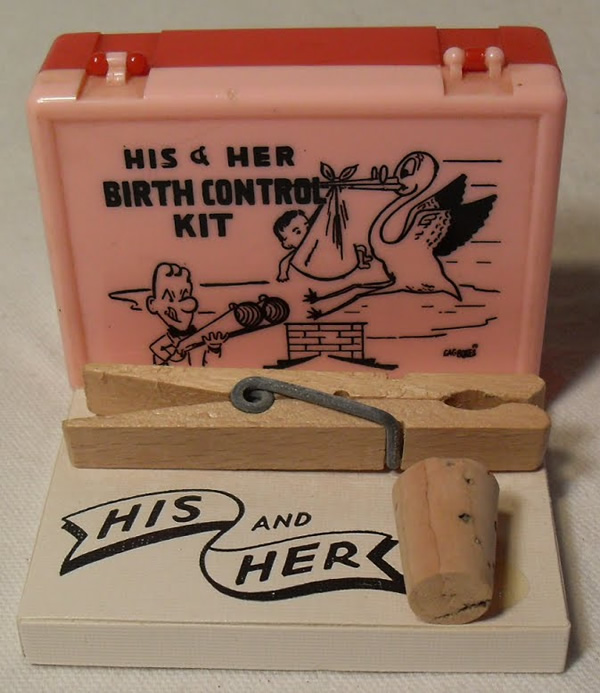

 The Navy's new strategy for sacving the world. In the U.S. Navy, flaoting hospital ships are curing the sick and healing the blind. It's all part of hte Pentagon's plan for global domination.
The Navy's new strategy for sacving the world. In the U.S. Navy, flaoting hospital ships are curing the sick and healing the blind. It's all part of hte Pentagon's plan for global domination.  After years of failing to pacify Iraq with firepower, the Pentagon decided it needed to think outside the arsenal. The result was a new theory called "soft power." The idea is to send the military into potential conflict zones—along with other government agencies and civilian volunteers—years before any fighting breaks out. The troops hand out free medical care, aid local governments, and build roads and schools. Basically, they do anything they can to be of assistance.
After years of failing to pacify Iraq with firepower, the Pentagon decided it needed to think outside the arsenal. The result was a new theory called "soft power." The idea is to send the military into potential conflict zones—along with other government agencies and civilian volunteers—years before any fighting breaks out. The troops hand out free medical care, aid local governments, and build roads and schools. Basically, they do anything they can to be of assistance.
 Naturally, the setup for all of this is fairly complex. Teams of doctors and nurses go ashore and establish "instant" health clinics. There, people can get treatment for simple medical and dental problems; they can pick up free meds from a portable pharmacy or free eyeglasses from a military optometrist; they can even get basic veterinary treatment for their pets and livestock. But when the procedures are more complicated, the Navy transports patients onto the ships. In Latin America in 2008, Operation Smile, a nonprofit organization specializing in facial plastic surgery, set up shop aboard the Kearsarge and shuttled in patients. During the ship's four-month tour, its doctors treated 15,000 people and repaired 200 severe cleft palates.
Naturally, the setup for all of this is fairly complex. Teams of doctors and nurses go ashore and establish "instant" health clinics. There, people can get treatment for simple medical and dental problems; they can pick up free meds from a portable pharmacy or free eyeglasses from a military optometrist; they can even get basic veterinary treatment for their pets and livestock. But when the procedures are more complicated, the Navy transports patients onto the ships. In Latin America in 2008, Operation Smile, a nonprofit organization specializing in facial plastic surgery, set up shop aboard the Kearsarge and shuttled in patients. During the ship's four-month tour, its doctors treated 15,000 people and repaired 200 severe cleft palates.
 In reality, soft power isn't perfect. A visit by one of the Navy's hospital ships is like instantly building a brand-new, full-service hospital in one of the world's poorest communities, running it at full capacity for two weeks, and then shutting it down in an afternoon. All the high technology can't replace the sustained, hands-on care a patient could get from a permanent, local clinic. Comfort surgeon Commander Timothy Donahue, for instance, admits that he had to avoid doing tricky procedures that could require highly specialized follow-up care.
In reality, soft power isn't perfect. A visit by one of the Navy's hospital ships is like instantly building a brand-new, full-service hospital in one of the world's poorest communities, running it at full capacity for two weeks, and then shutting it down in an afternoon. All the high technology can't replace the sustained, hands-on care a patient could get from a permanent, local clinic. Comfort surgeon Commander Timothy Donahue, for instance, admits that he had to avoid doing tricky procedures that could require highly specialized follow-up care. In Africa, the Navy has faced similar problems. When the Nashville tried to set up a clinic for abused children in Gabon, none of the sailors gave a second thought to the camouflaged uniforms they were wearing. But when the children saw their military garb, they thought the Americans had come to enslave them. For several minutes, there was complete pandemonium, as the children ran, screamed, and hid. "They've had difficult lives," explained Gabriela Escudero, a State Department humanitarian official. In the end, it took Escudero's gentle coaxing to convince them that the sailors were there to help.
In Africa, the Navy has faced similar problems. When the Nashville tried to set up a clinic for abused children in Gabon, none of the sailors gave a second thought to the camouflaged uniforms they were wearing. But when the children saw their military garb, they thought the Americans had come to enslave them. For several minutes, there was complete pandemonium, as the children ran, screamed, and hid. "They've had difficult lives," explained Gabriela Escudero, a State Department humanitarian official. In the end, it took Escudero's gentle coaxing to convince them that the sailors were there to help. (
(


